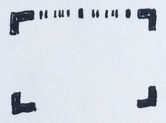At 7 am this morning my neighbors started throwing tree parts into a metal dumpster, which woke me up from a dream that Ted Nelson had changed his name so people would stop asking him for reprints of the Whole Earth Catalog but also about using retroreflective bar codes to identify objects.






Consider a foamcore piece on big board. Put retroreflective tape on the corners, and also a strip along the top edge. Then print out a mask (either white ink on transparent plastic, or laser-cut white paper with holes) with a barcode pattern, and overlay it on the top edge. If the mask is the same-ish color as the retroreflective tape, it shouldn't be too noticeable.

To the IR camera, it should look like

How many unique IDs could we represent with this barcode? Back of the envelope:
Big board's camera coverage would be about 16 DPI with a 1080p camera.

The smallest piece of foamcore is about 8" wide, or 128 camera pixels.

If we make our bars 4 px wide, that fits 32 bars.
If, for verification, we say that the top strip will have two identical copies of the code side-by-side, that gives us 16-bit codes.

If we discard codes with runs of 4 or more 0s or 1s, that's about 22,900 unique IDs. (The copies and the discarded codes are about trying to avoid misidentification when parts of the code are blocked by a hand or body, which will happen frequently.)
22,900 should be "enough for anyone"?